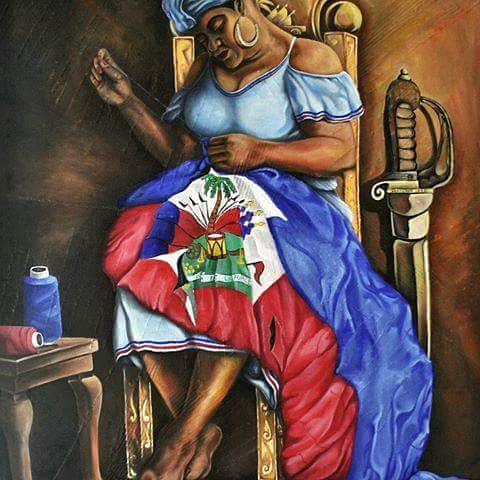Take a piece of this white & sew it together with cloths of red and blue, wave it high and wide as we celebrate this Haitian Flag Day with you! Thanks to the hands of Catherine Flon and stories orally passed down each year we give an ode to Haiti and their flag.
This Bicolour Flag is not only apart Haitian heritage but should be honored by all cultures. Looking back in history Haiti is not often recognized or given the praises we all should be sending in their direction.
This Haitian Flag Day Abantu Roots would like to share what Haiti has contributed to world-changing trends.
.
10. Most Valuable
Lately, Haiti has been labeled one of the poorest countries in the world. It is often forgotten that Haiti once was the most valuable colony in the West Indies. Sugar and coffee was Haiti’s gold and Haiti also housed the largest slave population outside of Brazil.
9. Haiti’s Middle Class
Because of the value of Haiti, even free blacks were able to build themselves up along with the French Plantation owners. Free Blacks were the product of slave women and French fathers who granted them their freedom. With their freedom, this population of 24k black peoples used their status to produce stability in their land. They served in the Militia, gained access to the property of their own and even ran their own plantations.
8. Educated Mulattos and Freed Blacks
Received their education from schools in France. By educating their minds, these students were able to articulate their concerns as free people. Their petition of free and equal rights was received and considered by France’s Government.
7.Vincent Oge’ and his Proposal
During the French Revolution, it was freed mulatto Vincent Oge’ who paired freed man Julien Raimond and a white lawyer Etienne Dejoly to fight to abolish slavery in Saint-Domingue. The Society of the Friends of the Blacks founded by Jacques Pierre Brissot helped these three men apply pressure to the French Assembly to allow voting rights. At this time there were racial laws that restricted the rights of freedmen because of colorism.
6. Fight first Forgiveness Later
Before emancipation was even a thought in the United States, freed blacks and the mulatto population in Saint Domingue were given a decree of rights. This meant for a temporary time, these free people had access to political rights. This small privilege was granted by the French National Assembly, after hearing of the execution of Leader Vincent Oge’. Compared to the US, this achievement was taboo. In the year 1791, the constitution had just been completed.
5. Vodou a religion Tabooed now Accepted
In 1991 after over a century of being castigated by the United States and Europe, Vodou was recognized as a National Religion. Out of this beautiful recognition a new Jazz movement was created called Racines Roots. Racines is Vodou rhythms combined with guitars, keyboards, and vocals. To know Vodou is to understand how it played a major part in Haiti’s perseverance. Without this belief of passed down Taino rituals combined with traditional religious practices from Africa the strength that Haiti used to overthrow their oppressors would have been bound with the slave chains.
4. First “Found” & First Freed.
Tribe, we know that it is impossible to “Find” a place that was already inhabited, but thanks to revisiting history we know that Haiti was the first place in the Caribbean that was colonized by European settlers. Under French rule, Haiti quickly became the richest colony. In the result of these trying times, the land is known as the “Cradle of Life” got the ultimate victory out of this which is still remembered today. The Haitian Revolution is THE ONLY, “THE ONLY” successful slave revolution in history.
3. Toussaint L’Ouverture’s Transformation
The Haitian Revolution would have not been successful if it was not for the military training of Toussaint L’Ouverture. He taught the men of his army to match their oppressor’s army and he did not stop there. Toussaint was also able to build the economy and strengthen the security in Saint-Domingue.
2. First Black Republic
Continuing the trend of being the first; on the 1st of January in 1804, it was at Gonaives where Jean Jacques Dessalines and his generals met and established the First Republic governed by men of African descent. Victory travels fast, so fast that the revolt in Haiti had Plantation owners in the antebellum south fearful of a similar revolution brewing in their fields. This creation of this Black Republic, on the other hand, was a needed opportunity for Blacks.
1.The Aider and Abetter
When you think of the term mentioned above it is often considered as a negative but in Haiti’s case, this is a double positive. If you were to take a look at both the Venezuelan’s flag and the Columbian flag you can see the homage that is given to Haiti. All three flags have the bi-colors of blue and red. During the early 1800s, slavery was still thriving in Venezuela, Colombia, Peru, Chile, modern Bolivia was under Spanish rule. Just like Toussaint L’Ouverture helped establish an army in Haiti, It was Alexandre Petition who aided these South American countries with the tools they needed for Freedom.
Tribe it has been a fun celebration Haitian Flag day with you! If you are interested in reading or hearing more things related to Haiti and Venezuela, stay tuned. ‘Who Owns Haiti?” will be available soon on all Abantu Audio Platforms.
Peace and continue to stay grounded in your Roots

